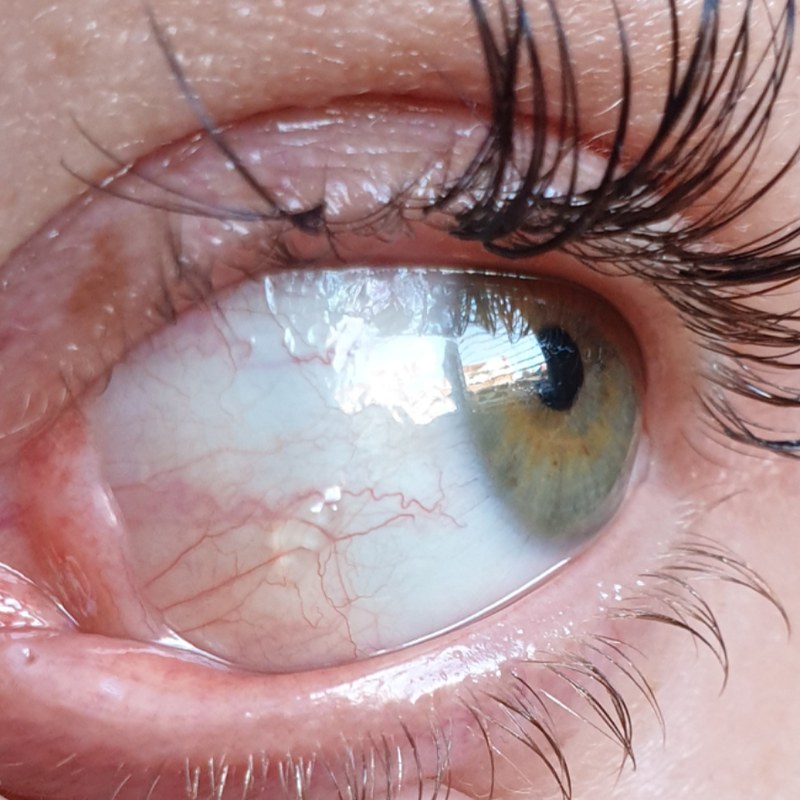
First-order neuron: fibers from Edinger-Westphal nucleus → oculomotor nerve fibers (located in the periphery of the oculomotor nerve) → ciliary ganglion.Contraction of the iris sphincter muscle (surrounds pupil).Definition: constriction of the pupil ( Indirectly by relaxation of the iris sphincter muscle.
 Third-order neuron: postganglionic sympathetic fibers form a plexus along the internal carotid artery → cavernous sinus → plexus forms long ciliary nerve and enter superior orbital fissure → dilator muscle of the iris ( pupillary dilation), superior tarsal muscle of the eyelid (upper eyelid retraction), sweat glands of the upper face. Second-order neuron: preganglionic sympathetic fibers (exit from the T 1 segment of the spinal cord) → rises to the upper cervical region along the cervical sympathetic trunk (passes near subclavian vessels and lung apex) → sympathetic trunk → superior cervical ganglion. First-order neuron: sympathetic hypothalamic fibers → lateral intermediate columns of the spinal cord → ciliospinal center of Budge ( C8–T2). Contraction of the iris dilator muscle (surrounds the peripheral part of iris). Definition: dilation of the pupil ( > 4 mm in daylight). Pupillary control is mediated by both parasympatheticand sympatheticinnervation. Accommodation: preganglionic parasympathetic fibers from Edinger-Westphal nucleus travel with the oculomotor nerve → ciliary muscle contraction → increased lens convexity. Convergence: contraction of both medial rectus muscles → eyes look inward. Miosis: contraction of iris sphincter muscle. Accommodation reflex: The synkinetic constriction of the pupil ( miosis), convergence of the eyes, and accommodation of lens convexity in response to a suddenly closer object. Occurs via the medial recti muscles bilaterally and is mediated by the oculomotor nerve ( CN III). Simultaneous inward movement of both eyes to maintain focus on close objects (e.g., eyes crossing when looking at one's own nose). Constricted ciliary muscle → relaxed ciliary processes → curvature of lens increases. Relaxed ciliary muscle → tense ciliary processes → curvature of lens decreases. Changes occur via contraction of ciliary muscles and are mediated by the Edinger-Westphal nuclei bilaterally. Primarily mediated by the lens, which changes convexity to adapt the refractory power. Accommodation: adjustment of the eyes to different distances (near vision versus far vision). impairment of the pupillary reflex) → pupils are anisocoric Isolated unilateral efferent pupillary defect (i.e. Sympathetic nervous system mediates motor innervation of the iris dilatator muscle.
Third-order neuron: postganglionic sympathetic fibers form a plexus along the internal carotid artery → cavernous sinus → plexus forms long ciliary nerve and enter superior orbital fissure → dilator muscle of the iris ( pupillary dilation), superior tarsal muscle of the eyelid (upper eyelid retraction), sweat glands of the upper face. Second-order neuron: preganglionic sympathetic fibers (exit from the T 1 segment of the spinal cord) → rises to the upper cervical region along the cervical sympathetic trunk (passes near subclavian vessels and lung apex) → sympathetic trunk → superior cervical ganglion. First-order neuron: sympathetic hypothalamic fibers → lateral intermediate columns of the spinal cord → ciliospinal center of Budge ( C8–T2). Contraction of the iris dilator muscle (surrounds the peripheral part of iris). Definition: dilation of the pupil ( > 4 mm in daylight). Pupillary control is mediated by both parasympatheticand sympatheticinnervation. Accommodation: preganglionic parasympathetic fibers from Edinger-Westphal nucleus travel with the oculomotor nerve → ciliary muscle contraction → increased lens convexity. Convergence: contraction of both medial rectus muscles → eyes look inward. Miosis: contraction of iris sphincter muscle. Accommodation reflex: The synkinetic constriction of the pupil ( miosis), convergence of the eyes, and accommodation of lens convexity in response to a suddenly closer object. Occurs via the medial recti muscles bilaterally and is mediated by the oculomotor nerve ( CN III). Simultaneous inward movement of both eyes to maintain focus on close objects (e.g., eyes crossing when looking at one's own nose). Constricted ciliary muscle → relaxed ciliary processes → curvature of lens increases. Relaxed ciliary muscle → tense ciliary processes → curvature of lens decreases. Changes occur via contraction of ciliary muscles and are mediated by the Edinger-Westphal nuclei bilaterally. Primarily mediated by the lens, which changes convexity to adapt the refractory power. Accommodation: adjustment of the eyes to different distances (near vision versus far vision). impairment of the pupillary reflex) → pupils are anisocoric Isolated unilateral efferent pupillary defect (i.e. Sympathetic nervous system mediates motor innervation of the iris dilatator muscle. 
Parasympathetic nervous system mediates motor innervation of the iris sphincter muscle.Efferent neural pathway (efferent limb): impulse transmission to the iris sphincter muscle.Illumination of the unaffected eye leads to normal pupillary constriction in both eyes.Illumination of the affected eye leads to reduced/absent constriction of both pupils.Isolated unilateral afferent pupillary defect(e.g.
#Blown pupil registration
Registration of light stimulus in the eye and transmission of the impulse to the central nervous system.Afferent neural pathway (afferent limb).Fixed pupil: the absence of pupillary response to a light stimulus or convergence testing.Isocoria: the pupils of both eyes are the same size.






 0 kommentar(er)
0 kommentar(er)
